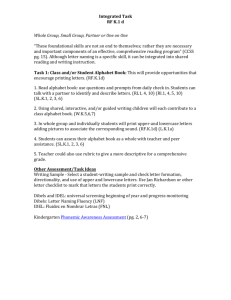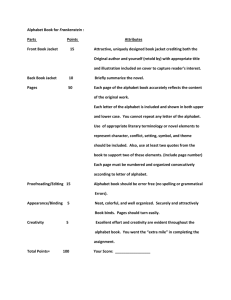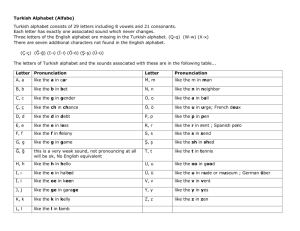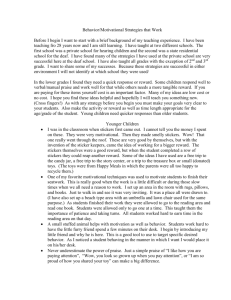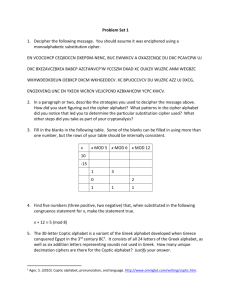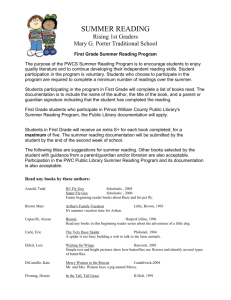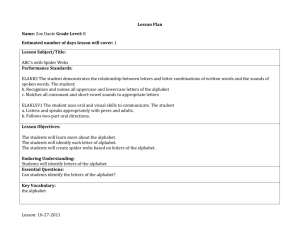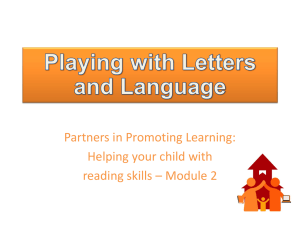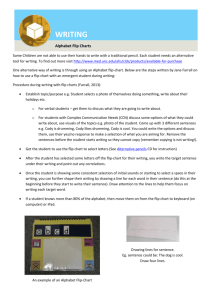Creative Ideas for Young Learners
advertisement
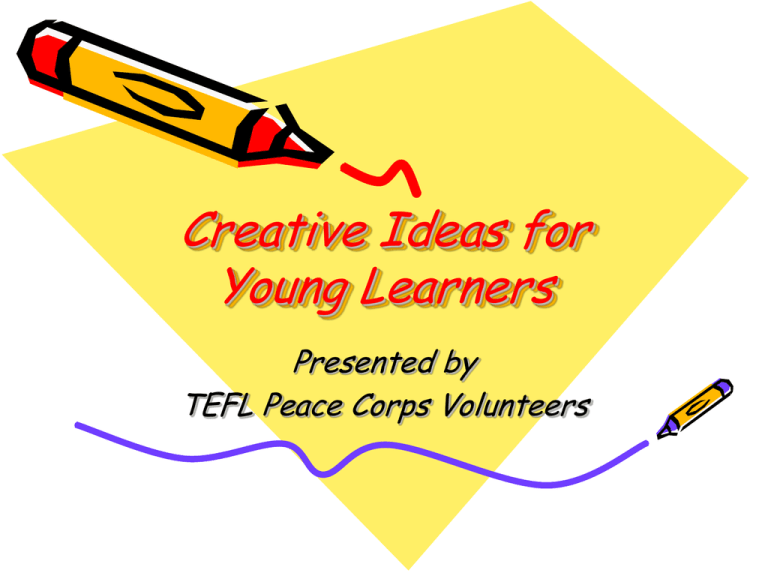
Creative Ideas for Young Learners Presented by TEFL Peace Corps Volunteers Classroom Supplies • Scissors • Glue Sticks • Markers, Coloured Pencils, Crayons • Pencil Sharpeners • Rubbers (Erasers) • Rulers • Paper (plain and coloured) • Stapler • Stickers • • • • • Flash cards Pictures Alphabet letters Alphabet puzzles Books with pictures Language Focus Vocabulary for things in the classroom and asking questions: Vocabulary for imperatives: • May I have the scissors? • May I have the glue? • May I have some markers/crayons? • • • • • • Cut Paste/glue Colour Erase Write Draw Alphabet Pages, Create Supplemental Material • www.kindergarten.com • www.learningpage.com (free clipart) Make a Book • • • • • My Alphabet Book My Book of Colours My Book of Numbers My Book of Shapes My Book of Opposites/Adjectives Arts & Crafts • • • • • Alligator Frog Spider Bookmarks Cards Puzzles • • • • • www.bogglesworld.com Make your own crossword Word Find Word Discovery (e.g. snowflakes) Word Shapes Total Physical Response (TPR) • • • • Alphabet Numbers Role playing / drama Charades Games & Songs • Bingo (colours, numbers, shapes, etc.) • Hangman (vocabulary, spelling practice) • Charades (flash cards—adjectives, adverbs, verbs, jobs, etc.) • Songs (Hokey Pokey—vocabulary for the body, Old MacDonald— vocabulary for animals, alphabet song—military style) Why Teach Using Games? • Games keep life interesting for the students and the teacher. They allow the students to interact more with the material and with each other in real language situations, making class time more productive and making the material more memorable. Myths & Realities • • Myth: It takes too much time to plan and prepare for games. Reality: It takes a little bit of extra time, but only in the beginning. Put your students to work. Often they can do the work in one class hour or for homework and use the material in the next hour for the game. After that, recycling is key. Once you build up a stock of games, you can modify them for many situations. • Myth: There’s too much textbook material to cover, so there’s no time for games. Reality: There is too much textbook material to cover, but it can be covered at a deeper level and in a more interesting way through adaptation to games. Many textbook activities are better given as homework. Focus on planning games, not planning homework – let the textbook do that for you. • • • Myth: It’s more important for students focus on grammar drills and mastering certain grammatical structures. Reality: At the elementary level, it’s more important that students have a good experience with the language and that they learn to be comfortable speaking. Fundamentals of Using Games 1. Remind students that games still involve learning – write the topic on the board, as well as a textbook page number. Give homework based on the game. Make the game part of their learning, not something outside of it. 2. Teach students the basic procedures of gameplaying. a. Explain and demonstrate the game. b. Have them tell/show you how to play. c. Each member of the group must participate. d. Each group will be expected to demonstrate some aspect of the game. 3. Make sure the games are content-based and that the students are producing something with the language. The important thing isn’t the game itself but how the students use the language. 4. Monitor the whole process – checking in with each group once is not enough. 5. Save time at the end of the class hour for a summary of the topic – have groups demonstrate use of a grammatical structure or word. 6. Noise and chaos are part of group work. The best way to keep the noise level down is to stay close to the students by moving from group to group, checking on their process. Ideas For Games 1. Vocabulary a. Ball (also works for sequences – numbers, days, months, alphabet, etc.; also verb conjugations or tense changes) b. Bingo (can give words in native language or give definitions) c. Charades (works best with verbs) d. Group races (works best for reviewing categories of vocabulary) e. “I’m going on a picnic ...” 2. Grammar – mostly verb tenses a. Tic Tac Toe b. Five in a Row c. I Know Everything (for questions) d. Board game e. Time game Motivation Games are a good way to motivate students -- use them more often and find other ways to motivate students: • Sticker charts: Reward/penalize students individually. This works better with younger students. They get a sticker next to their name on a chart if they are on time, have complete homework and aren’t disruptive in class; after 10 stickers they get a little reward – stickers, an eraser, etc. You can do it without stickers and without material rewards – the reward could be library/reading time, or a special game, or having class outside. • Points plan – Reward/penalize students as a group. This works better with older students. Here’s an example: A class starts with 20 points. When they reach 250 points, they get to watch a movie during class time. Write the points on the board each day (but also keep track of them in a notebook). Resources Websites: • • • • • • • • • • • www.kindergarten.com www.learningpage.com www.bogglesworld.com www.eflcub.com www.enchantedlearning.com www.abcteach.com www.btinternet.com/~ted.power www.englishbanana.com http://iteslj.org/links/ http://www.LessonPlansPage.com www.theholidayzone.com Interactive Websites: • www.lisaexplains.com (website for kids for web design) • www.discovery.com • www.starfall.com Song Book: • Old Favorites For All Ages by Anna Maria Malkoç
